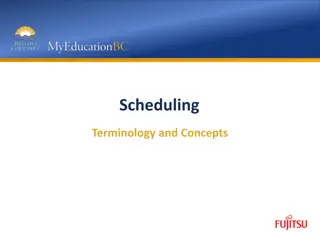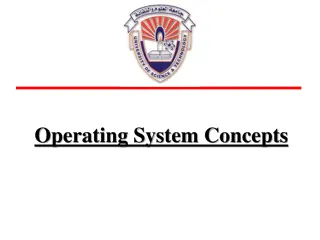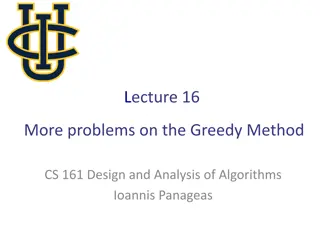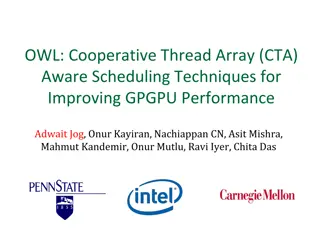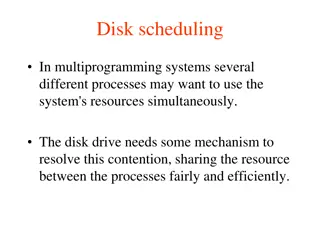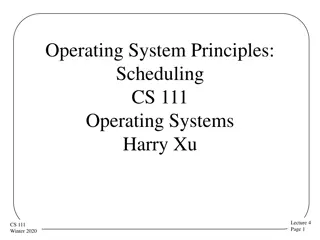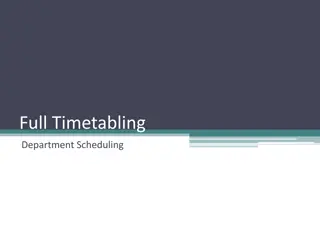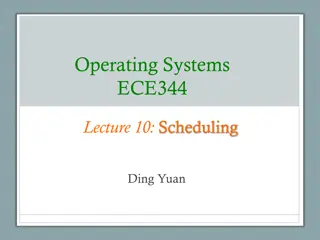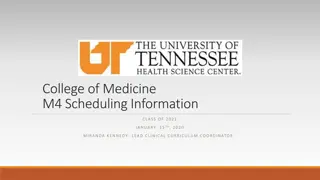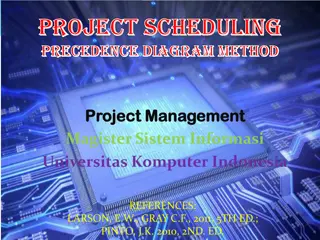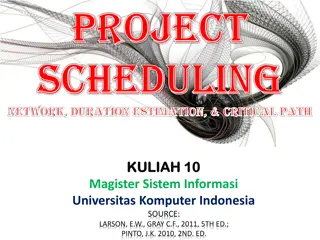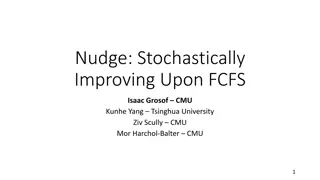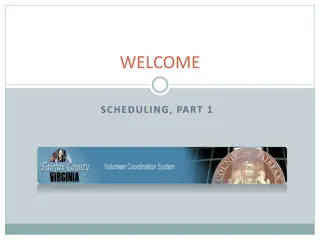Overview of Standard Method of Resource Scheduling for Effective Project Management
Resource Schedule Documents (RSD) prepared using Standard Method of Resource Scheduling 1 (SMRS 1) facilitate efficient allocation, planning, and management of resources. The RSD includes sections detailing employer and contractor responsibilities, material issues, method statements, and charges. SMRS provides reference codes for standardized work measurement units. Steps to prepare a resource schedule involve design analysis, quantity breakdown, market prices, and installation costs. An example of a Bill of Quantities for in-situ concrete is provided.
Download Presentation

Please find below an Image/Link to download the presentation.
The content on the website is provided AS IS for your information and personal use only. It may not be sold, licensed, or shared on other websites without obtaining consent from the author. Download presentation by click this link. If you encounter any issues during the download, it is possible that the publisher has removed the file from their server.
E N D
Presentation Transcript
OVERVIEW OF STANDARD METHOD OF RESCOURCE OVERVIEW OF STANDARD METHOD OF RESCOURCE SCHEDULLING SCHEDULLING HUSSAINI A. DIKKO; FNIQS, PPNIQS HUSSAINI A. DIKKO; FNIQS, PPNIQS RESENTATION TO THE NIGERIA INSTITUTE OF QUANTITY RESENTATION TO THE NIGERIA INSTITUTE OF QUANTITY SURVEYORS ON TRAIN THE TRAINERS WORKSHOP SURVEYORS ON TRAIN THE TRAINERS WORKSHOP
Resource Schedule documents (RSD) is prepared using Standard Method of Resource Scheduling 1 (SMRS 1) for effective allocation, planning and management of resources The RSD consist of the followings sections Employer's/Contractors responsibility Contractors responsibility Material issue Method statement and charge Ref/No DESCRIPTION Qty Unit Rate Amount Work Gangs(s) Plant/Tools Items Reference/Number Description Employer s/ Contractors Responsibility Materials issue Contractors Responsibility Method Statement and Charges
REFERENCE/NUMBER The SMRS document provided reference code for items of works which can be refer for better standardization of the measurement units. DESCRIPTION The document required that a detail description of the work items must be provided which must include the measured quantity of the work item. EMPLOYER S/ CONTRACTORS RESPONSIBILITY MATERIALS ISSUE This section is the materials analysis where the measured quantity is broken down into various material components with their prices required for the work item. We have the unit, quantities and market prices under this section. The procurement of these materials can either hand by the Employer or the contractor as the case maybe. CONTRACTORS RESPONSIBILITY METHOD STATEMENT AND CHARGES This section is the installation cost of the item of work and charges for tools used for the installation. The Contractor is responsible for the execution and installation of the work items. STEPS REQUIRED TO PREPARE RESOURCE SCHEDULE ARE : Designs or Bills of Quantities Breakdown analysis of the measured quantities into various materials components required Prevailing Market prices of the various materials Cost of installation and rent/hire charges for equipment/tools required for the installation
E IN SITU CONCRETE/LARGE PRECAST CONCRETE An example of the Bill of Quantities page E10 INSITU CONCRETE PLAIN: GRADE 15 Beds A not exceeding 150 thick; poured on or against earth or sand blinding; as blinding m3 12 15 000 180 000.00 PLAIN: GRADE 20 Foundation B Foundation m3 31 17 500 542 500.00 REINFORCED: GRADE 25 C Column bases m3 32 21 000 672 000.00 Columns D Isolated columns m3 33 21 000 693 000.00 Beds E 150-450mm thick m3 85 21 000 1 785 000.00 Slabs; 150-450mm thick F Suspended slab m3 84 21 000 1 764 000.00 G Wordrobe slab; not exceeding 150mm m3 2 21 000 42 000.00 Beam; 150-450mm thick H Attached m3 24 21 000 504 000.00 J Lintel m3 13 21 000 273 000.00 K Roof m3 9 21 000 189 000.00 Staircase L Stairs and landing m3 6 21 000 126 000.00 E20 FORMWORK FOR IN SITU CONCRETE FORMWORK: SAWN TO Sides of Column bases M Plain vertical; height 250-500mm high m 351 330 115 830.00 Edges of bed N Plain vertical; height not exceeding 250mm m 183 330 60 390.00 Columns; Isolated; Plain P Sides of columns; Rectangular section m2 517 1 100 568 700.00 To Collection 7 515 420.00
Material Analysis E IN SITU CONCRETE/LARGE PRECAST CONCRETE Cement Sand Aggregate An example of the breakdown analysis worksheet A Grade 15; Blinding ne150 thk m3 12 42 2 3 B Grade 20; Strip Foundation m3 31 136 5 7 The materials components of the various items of work are determine using the standard conversion factor REINFORCED: GRADE 25 Example of this factors are: C Column bases m3 32 198 5 7 1. 1m3 of Concrete Grade 15 has 3.5 bags of cement (50kg). D Isolated columns m3 33 205 5 7 2. 1m3 of concrete grade 20 has 4.3 bag of cement (50kg). E Bed Slab 150-450mm thick m3 85 527 12 19 F Suspended slab m3 84 521 12 19 1126.667 G Wordrobe slab; not exceeding 150mm m3 2 12 2/7 4/9 H Attached beams m3 24 149 3 5 J Lintel m3 13 81 2 3 K Roof m3 9 56 1 2 L Stairs and landing m3 6 37 1 1 E20 FORMWORK FOR IN SITU CONCRETE FORMWORK: SAWN TO Plank Bracer Props M Column bases Plain vertical m 351 99 12 N Edges of ground slab Plain vertical m 183 52 6 P Sides of columns; Rectangular section m2 517 488 326
Employer's/Contractors responsibility Material issue Contractors responsibility Method statement and charge An example of resource schedule page Ref/No DESCRIPTION Qty Unit Rate Amount Work Gangs(s) Plant/Tools Items D10: IN-SITU AND PRECAST CNCRETE BLINDING (1:4:8), Grade 15 (12m3) D10:1.1.1 15 060.00 8 283.00 D10:1.1.1.1 50kg bag of cement (Dangote) 43 gnr of bags 1 450 62 350.00 2 3.81m3/trips D10:1.1.1.2 Sharp sand (Open Market) 12 000 24 000.00 Under the Employer s/contractor responsibility (materials issue) can be procure by either the Employer or the contractor their implications are as follows: 3 3.81m3/trips D10:1.1.1.3 Gravel (Open Market) 17 000 51 000.00 FOUNDATION (1:3:6), Grade 20 (31m3) D10:2.1.1 38 905.00 21 397.75 D10:2.1.1.1 50kg bag of cement (Dangote) 136 gnr of bags 1 450 197 150.70 5 3.81m3/trips D10:2.1.1.2 Sharp sand (Open Market) 12 000 54 774.80 7 3.81m3/trips D10:2.1.1.3 Gravel (Open Market) 17 000 124 156.22 COLUMNS BASE (1:2:4), Grade 25 (32m3) D10:2.1.1 40 160.00 22 088.00 D10:2.1.1.1 50kg bag of cement (Dangote) 198 gnr of bags 1 450 287 754.24 5 3.81m3/trips D10:2.1.1.2 Sharp sand (Open Market) 12 000 54 485.67 7 3.81m3/trips D10:2.1.1.3 Gravel (Open Market) 17 000 122 335.75 GROUND SLAB (1:2:4), Grade 25 (85m3) D10:4.1.1 106 675.00 58 671.25 D10:4.1.1.1 50kg bag of cement (Dangote) 527 gnr of bags 1 450 764 347.20 12 3.81m3/trips D10:4.1.1.2 Sharp sand (Open Market) 12 000 144 727.56 19 3.81m3/trips D10:4.1.1.3 Gravel (Open Market) 17 000 324 954.33 SUSPENDED SLAB (1:2:4), Grade 25 (84m3) D10:5.1.1 105 420.00 57 981.00 D10:5.1.1.1 50kg bag of cement (Dangote) 521 gnr of bags 1 450 755 354.88 12 3.81m3/trips D10:5.1.1.2 Sharp sand (Open Market) 12 000 143 024.88 19 3.81m3/trips D10:5.1.1.3 Gravel (Open Market) 17 000 321 131.34
For the Employer to procure materials for construction means: The contractor is not responsible for quality of the materials. the optimization of materials wastage will not be practicable as the contractor is not responsible for material procurement. The employer must engage a specialist who must advice him on material procurement to ensure that quality is attain and also they have to be additional supervision on the contractor installation to avoid wastages of materials. The contractor is responsible for the quality of the materials. the contractor can compromise on the quality of the materials in order to maximize his profit. The Employer must put a frame work of supervision to ensure that proper advice on quality of materials is not compromise in during procurement. For the Contractor to procure materials for construction means:
Contractors responsibility method statement and charges We assess the contractor method statement and charges with regards to the various installation techniques used in the construction industry. We then assumed the midway between the mechanize and direct labour cost of installation. Based on our findings we used the following assumption. 1. installation of reinforcement is N40/kg 2. installation concrete is N3500/m3 3. laying of block wall is N35/block etc Contractor and artisan normally resist use of the resource schedule document to administer project because it discloses the profit margin the contractor may likely get at the end of the project. In most cases the industry tend to deal with this on the basis of lump sums and lump sums are not useful because they are arbitrary and not realistic. In the event that lump sum is agreed with contractor, the importance of the resource schedule document will serve as a guide to ensure that the lumpsum agreed was based on an informed decision.
On our estimations for labour cost of installation constants and materials usage, must have to be put to test over time and be refine to be updated so that it can be practical . The End









